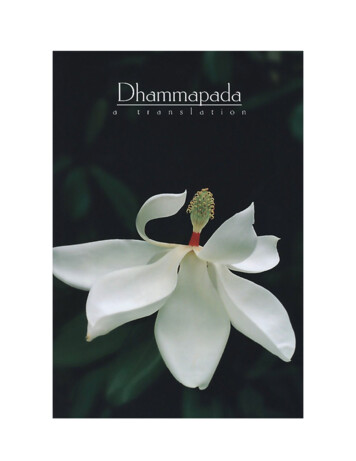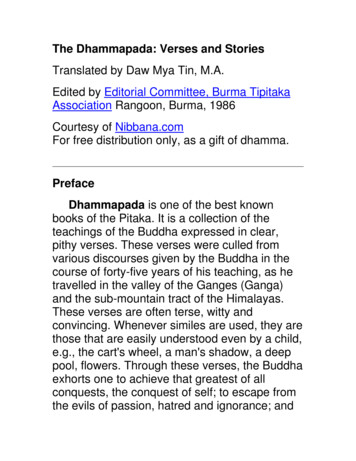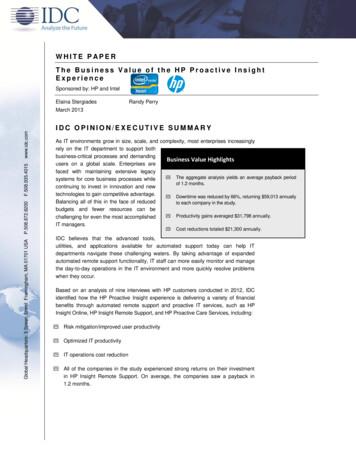
Transcription
2DhammapadaA TranslationbyThanissaro Bhikkhu(Geoffrey DeGraff)
3Copyright Thanissaro Bhikkhu 1998This book may be copied or reprinted for free distributionwithout permission from the publisher.Otherwise all rights reserved.Revised edition, 2011.
4ContentsPrefaceIntroductionI : PairsII : HeedfulnessIII : The MindIV : BlossomsV : FoolsVI : The WiseVII : ArahantsVIII : ThousandsIX : EvilX : The RodXI : AgingXII : SelfXIII : WorldsXIV : AwakenedXV : HappyXVI : Dear OnesXVII : AngerXVIII : ImpuritiesXIX : The JudgeXX : The Path
5XXI : MiscellanyXXII : HellXXIII : ElephantsXXIV : CravingXXV : MonksXXVI : BrahmansHistorical NotesEnd NotesGlossaryAbbreviationsBibliography
6PrefaceAnother translation of the Dhammapada.Many other English translations are already available—the fingers of at least five peoplewould be needed to count them—so I suppose that a new translation has to be justified, toprove that it’s not “just” another one. In doing so, though, I’d rather not criticize the effortsof earlier translators, for I owe them a great deal. Instead, I’ll ask you to read theIntroduction and Historical Notes, to gain an idea of what is distinctive about the approachI have taken, and the translation itself, which I hope will stand on its own merits. Theoriginal impulse for making the translation came from my conviction that the text deservedto be offered freely as a gift of Dhamma. As I knew of no existing translations available asgifts, I made my own.The explanatory material is designed to meet with the needs of two sorts of readers:those who want to read the text as a text, in the context of the religious history of Buddhism—viewed from the outside—and those who want to read the text as a guide to the personalconduct of their lives. Although there is no clear line dividing these groups, theIntroduction is aimed more at the second group, and the Historical Notes more at the first.The End Notes and Glossary contain material that should be of interest to both. Versesmarked with an asterisk in the translation are discussed in the End Notes. Pali terms—aswell as English terms used in a special sense, such as effluent, enlightened one, fabrication, stress,and Unbinding—when they appear in more than one verse, are explained in the Glossary.In addition to the previous translators and editors from whose work I have borrowed, Iowe a special debt of gratitude to Jeanne Larsen for her help in honing down the languageof the translation. Also, John Bullitt, Gil Fronsdal, Charles Hallisey, Karen King, AndrewOlendzki, Ruth Stiles, Clark Strand, Paula Trahan, and Jane Yudelman offered manyhelpful comments that improved the quality of the book as a whole. Any mistakes thatremain, of course, are my own responsibility.Thanissaro BhikkhuMetta Forest MonasteryValley Center, CA 92082-1409December, 1997
7IntroductionThe Dhammapada, an anthology of verses attributed to the Buddha, has long beenrecognized as one of the masterpieces of early Buddhist literature. Only more recently havescholars realized that it is also one of the early masterpieces in the Indian tradition of kavya,or belles lettres.This translation of the Dhammapada is an attempt to render the verses into English in away that does justice to both of the traditions to which the text belongs. Although it istempting to view these traditions as distinct, dealing with form (kavya) and content(Buddhism), the ideals of kavya aimed at combining form and content into a seamless whole.At the same time, the early Buddhists adopted and adapted the conventions of kavya in a waythat skillfully dovetailed with their views of how teaching and listening played a role in theirpath of practice. My hope is that the translation presented here will convey the sameseamlessness and skill.As an example of kavya, the Dhammapada has a fairly complete body of ethical andaesthetic theory behind it, for the purpose of kavya was to instruct in the highest ends of lifewhile simultaneously giving delight. The ethical teaching of the Dhammapada is expressedin the first pair of verses: the mind, through its actions (kamma), is the chief architect ofone’s happiness and suffering both in this life and beyond. The first three chapters elaborateon this point, to show that there are two major ways of relating to this fact: as a wise person,who is heedful enough to make the necessary effort to train his/her own mind to be a skillfularchitect; and as a fool, who is heedless and sees no reason to train the mind.The work as a whole elaborates on this distinction, showing in more detail both the pathof the wise person and that of the fool, together with the rewards of the former and thedangers of the latter: the path of the wise person can lead not only to happiness within thecycle of death and rebirth, but also to total escape into the Deathless, beyond the cycleentirely; the path of the fool leads not only to suffering now and in the future, but also tofurther entrapment within the cycle. The purpose of the Dhammapada is to make the wisepath attractive to the reader so that he/she will follow it—for the dilemma posited by thefirst pair of verses is not one in the imaginary world of fiction; it is the dilemma in which thereader is already placed by the fact of being born.To make the wise path attractive, the techniques of poetry are used to give “savor” (rasa)to the message. Ancient Indian aesthetic treatises devoted a great deal of discussion to thenotion of savor and how it could be conveyed. The basic theory was this: Artisticcomposition expressed states of emotion or states of mind called “bhava.” The standard listof basic emotions included love (delight), humor, grief, anger, energy, fear, disgust, andastonishment. The reader or listener exposed to these presentations of emotion did notparticipate in them directly; rather, he/she savored them as an aesthetic experience at one
8remove from the emotion. Thus, the savor of grief is not grief, but compassion. The savor ofenergy is not energy itself, but admiration for heroism. The savor of love is not love but anexperience of sensitivity. The savor of astonishment is a sense of the marvelous. The proofof the indirectness of the aesthetic experience was that some of the basic emotions weredecidedly unpleasant, while the savor of the emotion was to be enjoyed.Although a work of art might depict many emotions, and thus—like a good meal—offermany savors for the reader/listener to taste, one savor was supposed to dominate. Writersmade a common practice of announcing the savor they were trying to produce, usuallystating in passing that their particular savor was the highest of all. The Dhammapada [354]states explicitly that the savor of Dhamma is the highest savor, which indicates that that isthe basic savor of the work. Classic aesthetic theory lists the savor of Dhamma, or justice, asone of the three basic varieties of the heroic savor (the other two deal with generosity andwar): thus we would expect the majority of the verses to depict energy, and in fact they do,with their exhortations to action, strong verbs, repeated imperatives, and frequent use of theimagery from battles, races, and conquests.Dhamma, in the Buddhist sense, implies more than the “justice” of Dhamma inaesthetic theory. However, the long section of the Dhammapada devoted to “The Judge”—beginning with a definition of a good judge, and continuing with examples of goodjudgment—shows that the Buddhist concept of Dhamma has room for the aestheticmeaning of the term as well.Classic theory also holds that the heroic savor should, especially at the end of a piece,shade into the marvelous. This, in fact, is what happens periodically throughout theDhammapada, and especially at the end, where the verses express astonishment at theamazing and paradoxical qualities of a person who has followed the path of heedfulness to itsend, becoming “pathless” [92-93; 179-180]—totally indescribable, transcending conflictsand dualities of every sort. Thus the predominant emotions that the verses express in Pali—and should also express in translation—are energy and astonishment, so as to producequalities of the heroic and marvelous for the reader to savor. This savor is then what inspiresthe reader to follow the path of wisdom, with the result that he/she will reach a directexperience of the true happiness, transcending all dualities, found at the end of the path.Classic aesthetic theory lists a variety of rhetorical features that can produce savor.Examples from these lists that can be found in the Dhammapada include: accumulation(padoccaya) [137-140], admonitions (upadista) [47-48, 246-248, et. al.], ambiguity(aksarasamghata) [97, 294-295], benedictions (asis) [337], distinctions (visesana) [19-20, 2122, 318-319], encouragement (protsahana) [35, 43, 46, et. al.], etymology (nirukta) [388],examples (drstanta) [30], explanations of cause and effect (hetu) [1-2], illustrations(udaharana) [344], implications (arthapatti) [341], rhetorical questions (prccha) [44, 62, 143,et. al.], praise (gunakirtana) [54-56, 58-59, 92-93, et. al.], prohibitions (pratisedha) [121-122,271-272, 371, et. al.], and ornamentation (bhusana) [passim].Of these, ornamentation is the most complex, including four figures of speech and ten
9“qualities.” The figures of speech are simile [passim], extended metaphor [398], rhyme(including alliteration and assonance), and “lamps” [passim]. This last figure is a peculiarityof Pali—a heavily inflected language—that allows, say, one adjective to modify two differentnouns, or one verb to function in two separate sentences. (The name of the figure derivesfrom the idea that the two nouns radiate from the one adjective, or the two sentences fromthe one verb.) In English, the closest we have to this is parallelism combined with ellipsis. Anexample from the translation is in verse 7—Mara overcomes himas the wind, a weak tree—where “overcomes” functions as the verb in both clauses, even though it is elided from thesecond. This is how I have rendered lamps in most of the verses, although in two cases [174,206] I found it more effective to repeat the lamp-word.The ten “qualities” are more general attributes of sound, syntax, and sense, includingsuch attributes as charm, clarity, delicacy, evenness, exaltation, sweetness, and strength. Theancient texts are not especially clear on what some of these terms mean in practice. Evenwhere they are clear, the terms deal in aspects of Pali/Sanskrit syntax not always applicableto English. What is important, though, is that some qualities are seen as more suited to aparticular savor than others: strength and exaltation, for example, best convey a taste of theheroic and marvelous. Of these characteristics, strength (ojas) is the easiest to quantify, for itis marked by long compounded words. In the Dhammapada, approximately one tenth of theverses contain compounds that are as long as a whole line of verse, and one verse [39] hasthree of its four lines made up of such compounds. By the standards of later Sanskrit verse,this is rather mild, but when compared with verses in the rest of the Pali Canon and otherearly masterpieces of kavya, the Dhammapada is quite strong.The text also explicitly adds to the theory of characteristics in saying that “sweetness” isnot just an attribute of words, but of the person speaking [363]. If the person is a trueexample of the virtue espoused, his/her words are sweet. This point could be generalized tocover many of the other qualities as well.Another point from classic aesthetic theory that may be relevant to the Dhammapada isthe principle of how a literary work is given unity. Although the text does not provide astep-by-step sequential portrait of the path of wisdom, as a lyric anthology it is much moreunified than most Indian examples of that genre. The classic theory of dramatic plotconstruction may be playing an indirect role here. On the one hand, a plot must exhibitunity by presenting a conflict or dilemma, and depicting the attainment of a goal throughovercoming that conflict. This is precisely what unifies the Dhammapada: it begins with theduality between heedless and heedful ways of living, and ends with the final attainment oftotal mastery. On the other hand, the plot must not show smooth, systematic progress;otherwise the work would turn into a treatise. There must be reversals and diversions tomaintain interest. This principle is at work in the fairly unsystematic ordering of theDhammapada’s middle sections. Verses dealing with the beginning stages of the path are
10mixed together with those dealing with later stages and even stages beyond the completionof the path.One more point is that the ideal plot should be constructed with a sub-plot in which asecondary character gains his/her goal, and in so doing helps the main character attain his orhers. In addition to the aesthetic pleasure offered by the sub-plot, the ethical lesson is one ofhuman cooperation: people attain their goals by working together. In the Dhammapada, thesame dynamic is at work. The main “plot” is that of the person who masters the principle ofkamma to the point of total release from kamma and the round of rebirth; the “sub-plot”depicts the person who masters the principle of kamma to the point of gaining a goodrebirth on the human or heavenly planes. The second person gains his/her goal, in part, bybeing generous and respectful to the first person [106-109, 177], thus enabling the firstperson to practice to the point of total mastery. In return, the first person gives counsel tothe second person on how to pursue his/her goal [76-77, 363]. In this way the Dhammapadadepicts the play of life in a way that offers two potentially heroic roles for the reader tochoose from, and delineates those roles in such a way that all people can choose to be heroic,working together for the attainment of their own true well being.Perhaps the best way to summarize the confluence of Buddhist and kavya traditions inthe Dhammapada is in light of a teaching from another early Buddhist text, the SamyuttaNikaya (55:5), on the factors needed to attain one’s first taste of the goal of the Buddhistpath. Those factors are four: associating with people of integrity, listening to theirteachings, using appropriate attention to inquire into the way those teachings apply to one’slife, and practicing in line with the teachings in a way that does them justice. EarlyBuddhists used the traditions of kavya—concerning savor, rhetoric, structure, and figures ofspeech—primarily in connection with the second of these factors, in order to make theteachings appealing to the listener. However, the question of savor is related to the otherthree factors as well. The words of a teaching must be spoken by a person of integrity whoembodies their message in his/her actions if their savor is to be sweet [158, 363]. The listenermust reflect on them appropriately and then put them into practice if they are to have morethan a passing, superficial taste. Thus both the speaker and listener must act in line with thewords of a teaching if it is to bear fruit. This point is reflected in a pair of verses from theDhammapada itself [51-52]:Just like a blossom,bright coloredbut scentless:a well-spoken wordis fruitlesswhen not carried out.Just like a blossom,bright colored& full of scent:a well-spoken word
11is fruitfulwhen well carried out.Appropriate reflection, the first step a listener should follow in carrying out the wellspoken word, means contemplating one’s own life to see the dangers of following the path offoolishness and the need to follow the path of wisdom. The Buddhist tradition recognizestwo emotions as playing a role in this reflection. The first is samvega, a strong sense ofdismay that comes with realizing the futility and meaningless of life as it is normally lived,together with a feeling of urgency in trying to find a way out of the meaningless cycle. Thesecond emotion is pasada, the clarity and serenity that come when one recognizes a teachingthat presents the truth of the dilemma of existence and at the same time points the way out.One function of the verses in the Dhammapada is to provide this sense of clarity, which iswhy verse 82 states that the wise grow serene on hearing the Dhamma, and 102 states thatthe most worthwhile verse is the meaningful one that, on hearing, brings peace.However, the process does not stop with these preliminary feelings of peace and serenity.The listener must carry through with the path of practice that the verses recommend.Although much of the impetus for doing so comes from the emotions of samvega and pasadasparked by the content of the verses, the heroic and marvelous savor of the verses plays a roleas well, by inspiring the listener to rouse within him or herself the energy and strength thatthe path will require. When the path is brought to fruition, it brings the peace and delightof the Deathless [373-374]. This is where the process initiated by hearing or reading theDhamma bears its deepest savor, surpassing all others. It is the highest sense in which themeaningful verses of the Dhammapada bring peace.* * *In preparing the following translation, I have kept the above points in mind, motivatedboth by a firm belief in the truth of the message of the Dhammapada, and by a desire topresent it in a compelling way that will induce the reader to put it into practice. Althoughtrying to stay as close as possible to the literal meaning of the text, I’ve also tried to conveyits savor. I’m operating on the classic assumption that, although there may be a tensionbetween giving instruction (being scrupulously accurate) and giving delight (providing anenjoyable taste of the mental states that the words depict), the best translation is one thatplays with that tension without submitting totally to one side at the expense of the other.To convey the savor of the work, I have aimed at a spare style flexible enough to expressnot only its dominant emotions—energy and astonishment—but also its transient emotions,such as humor, delight, and fear. Although the original verses conform to metrical rules, thetranslations are in free verse. This is the form that requires the fewest deviations from literalaccuracy and allows for a terse directness that conforms with the heroic savor of the original.The freedom I have used in placing words on the page also allows many of the poetic effectsof Pali syntax—especially the parallelism and ellipsis of the “lamps”—to shine through.I have been relatively consistent in choosing English equivalents for Pali terms,especially where the terms have a technical meaning. Total consistency, although it may be a
12logical goal, is by no means a rational one, especially in translating poetry. Anyone who istruly bilingual will appreciate this point. Words in the original were chosen for their soundand connotations, as well as their literal sense, so the same principles—within reasonablelimits—have been used in the translation. Deviations from the original syntax are rare, andhave been limited primarily to six sorts. The first four are for the sake of immediacy:occasional use of the American “you” for “one”; occasional use of imperatives (“Do this!”)for optatives (“One should do this”); substituting active for passive voice; and replacing “hewho does this” with “he does this” in many of the verses defining the true brahman inChapter 26. The remaining two deviations are: making minor adjustments in sentencestructure to keep a word at the beginning or end of a verse when this position seemsimportant (e.g., 158, 384); and changing the number from singular (“the wise person”) toplural (“the wise”) when talking about personality types, both to streamline the language andto lighten the gender bias of the original Pali. (As most of the verses were originallyaddressed to monks, I have found it impossible to eliminate the gender bias entirely, and soapologize for whatever bias remains.)In verses where I sense that a particular Pali word or phrase is meant to carry multiplemeanings, I have explicitly given all of those meanings in the English, even where this hasmeant a considerable expansion of the verse. (Many of these verses are discussed in thenotes.) Otherwise, I have tried to make the translation as transparent as possible, in order toallow the light and energy of the original to pass through with minimal distortion.The Dhammapada has for centuries been used as an introduction to the Buddhist pointof view. However, the text is by no means elementary, either in terms of content or style.Many of the verses presuppose at least a passing knowledge of Buddhist doctrine; othersemploy multiple levels of meaning and wordplay typical of polished kavya. For this reason, Ihave added notes to the translation to help draw out some of the implications of verses thatmight not be obvious to people who are new to either of the two traditions that the textrepresents.I hope that whatever delight you gain from this translation will inspire you to put theBuddha’s words into practice, so that you will someday taste the savor, not just of the words,but of the Deathless to which they point.
13I : PairsPhenomena arepreceded by the heart,ruled by the heart,made of the heart.If you speak or actwith a corrupted heart,then suffering follows you—as the wheel of the cart,the track of the oxthat pulls it.Phenomena arepreceded by the heart,ruled by the heart,made of the heart.If you speak or actwith a calm, bright heart,then happiness follows you,like a shadowthat never leaves.1-2*‘Heinsulted me,hit me,beat me,robbed me’—for those who brood on this,hostility isn’t stilled.He insulted me,hit me,beat me,robbed me’—for those who don’t brood on this,hostility is stilled.
14Hostilities aren’t stilledthrough hostility,regardless.Hostilities are stilledthrough non-hostility:this, an unending truth.Unlike those who don’t realizethat we’re here on the vergeof perishing,those who do:their quarrels are stilled.3-6One who stays focused on the beautiful,is unrestrained with the senses,knowing no moderation in food,apathetic, unenergetic:Mara overcomes himas the wind, a weak tree.One who stays focused on the foul,is restrained with regard to the senses,knowing moderation in food,full of conviction & energy:Mara does not overcome himas the wind, a mountain of rock.7-8*He who,depraved,devoidof truthfulness& self-control,puts on the ochre robe,doesn’t deserve the ochre robe.But he who is freeof depravityendowedwith truthfulness& self-control,well-establishedin the precepts,truly deserves the ochre robe.9-10
15Those who regardnon-essence as essenceand see essence as non-,don’t get to the essence,ranging about in wrong resolves.But those who knowessence as essence,and non-essence as non-,get to the essence,ranging about in right resolves.11-12*As rain seeps intoan ill-thatched hut,so passion,the undeveloped mind.As rain doesn’t seep intoa well-thatched hut,so passion does not,the well-developed mind.Here he grieveshe grieveshereafter.In both worldsthe wrong-doer grieves.He grieves, he’s afflicted,seeing the corruptionof his deeds.Here he rejoiceshe rejoiceshereafter.In both worldsthe merit-maker rejoices.He rejoices, is jubilant,seeing the purityof his deeds.Here he’s tormentedhe’s tormentedhereafter.In both worldsthe wrong-doer’s tormented.13-14
16He’s tormented at the thought,‘I’ve done wrong.’Having gone to a bad destination,he’s tormentedall the more.Here he delightshe delightshereafter.In both worldsthe merit-maker delights.He delights at the thought,‘I’ve made merit.’Having gone to a good destination,he delightsall the more.15-18*If he recites many teachings, but—heedless man—doesn’t do what they say,like a cowherd counting the cattle ofothers,he has no share in the contemplative life.If he recites next to nothingbut follows the Dhammain line with the Dhamma;abandoning passion,aversion, delusion;alert,his mind well-released,not clingingeither here or hereafter:he has his share in the contemplative life.19-20
17II : HeedfulnessHeedfulness: the path to the Deathless.Heedlessness: the path to death.The heedful do not die.The heedless are as ifalready dead.Knowing this as a true distinction,those wisein heedfulnessrejoice in heedfulness,enjoying the range of the noble ones.The enlightened, constantlyabsorbed in jhana,persevering,firm in their effort:they touch Unbinding,the unexcelled restfrom the yoke.Those with initiative,mindful,clean in action,acting with due consideration,heedful, restrained,living the Dhamma:their glorygrows.21-24*Through initiative, heedfulness,restraint, & self-control,the wise would makean islandno floodcan submerge.25
18They’re addicted to heedlessness—dullards, fools—while one who is wisecherishes heedfulnessas his highest wealth.Don’t give way to heedlessnessor to intimacywith sensual delight—for a heedful person,absorbed in jhana,attains an abundance of ease.When the wise person drives outheedlessnesswith heedfulness,having climbed the high towerof discernment,sorrow-free,he observes the sorrowing crowd—as the enlightened man,having scaleda summit,the fools on the ground below.Heedful among the heedless,wakeful among those asleep,just as a fast horse advances,leaving the weak behind:so the wise.Through heedfulness, Indra wonto lordship over the devas.Heedfulness is praised,heedlessness censured—always.2627282930
19The monk delighting in heedfulness,seeing danger in heedlessness,advances like a fire,burning fettersgreat & small.The monk delighting in heedfulness,seeing danger in heedlessness—incapable of falling back—stands right on the vergeof Unbinding.31-32
20III : The MindQuivering, wavering,hard to guard,to hold in check:the mind.The sage makes it straight—like a fletcher,the shaft of an arrow.Like a fishpulled from its home in the water& thrown on land:this mind flips & flaps aboutto escape Mara’s sway.Hard to hold down,nimble,alighting wherever it likes:the mind.Its taming is good.The mind well-tamedbrings ease.So hard to see,so very, very subtle,alighting wherever it likes:the mind.The wise should guard it.The mind protectedbrings ease.Wandering far,going alone,bodiless,lying in a cave:the mind.Those who restrain it:from Mara’s bondsthey’ll be freed.33-37*For a person of unsteady mind,not knowing true Dhamma,
21serenitysetadrift:discernment doesn’t grow full.For a person of unsoddened mind,unassaulted awareness,abandoning merit & evil,wakeful,there isno dangerno fear.Knowing this bodyis like a clay jar,securing this mindlike a fort,attack Marawith the spear of discernment,then guard what’s wonwithout settling there,without laying claim.All too soon, this bodywill lie on the groundcast off,bereft of consciousness,like a useless scrapof wood.Whatever an enemy might doto an enemy,or a foe to a foe,the ill-directed mindcan do to youeven worse.3839*40*41
22Whatever a mother, fatheror other kinsmanmight do for you,the well-directed mindcan do for youeven better.42-43*
23IV : BlossomsWho will penetrate this earth& this realm of deathwith all its gods?Who will ferret outthe well-taught Dhamma-saying,as the skillful flower-arrangerthe flower?The learner-on-the-pathwill penetrate this earth& this realm of deathwith all its gods.The learner-on-the-pathwill ferret outthe well-taught Dhamma-saying,as the skillful flower-arrangerthe flower.44-45*Knowing this bodyis like foam,realizing its nature—a mirage—cutting outthe blossoms of Mara,you go where the King of Deathcan’t see.46The man immersed ingathering blossoms,his heart distracted:death sweeps him away—as a great flood,a village asleep.The man immersed ingathering blossoms,his heart distracted,
24insatiable in sensual pleasures:the End-Maker holds himunder his sway.As a bee—without harmingthe blossom,its color,its fragrance—takes its nectar & flies away:so should the sagego through a village.Focus,not on the rudenesses of others,not on what they’ve doneor left undone,but on what youhave & haven’t doneyourself.47-48*4950Just like a blossom,bright coloredbut scentless:a well-spoken wordis fruitlesswhen not carried out.Just like a blossom,bright colored& full of scent:a well-spoken wordis fruitfulwhen well carried out.Just as from a heap of flowersmany garland strands can be made,even soone born & mortalshould do—with what’s born & is mortal—51-52
25many a skillful thing.53*No flower’s scentgoes against the wind—not sandalwood,jasmine,tagara.But the scent of the gooddoes go against the wind.The person of integritywafts a scentin every direction.Sandalwood, tagara,lotus, & jasmine:among these scents,the scent of virtueis unsurpassed.Next to nothing, this scent—sandalwood, tagara—while the scent of virtuous conductwafts to the devas,supreme.Those consummate in virtue,dwellingin heedfulness,releasedthrough right knowing:Mara can’t follow their tracks.As in a pile of rubbishcast by the side of a highwaya lotus might growclean-smellingpleasing the heart,so in the midst of the rubbish-like,people run-of-the-mill & blind,there dazzles with discernmentthe disciple of the RightlySelf-Awakened One.54-56*57*58-59
26V : FoolsLong for the wakeful is the night.Long for the weary, a league.For foolsunaware of True Dhamma,samsarais long.60If, in your course, you don’t meetyour equal, your better,then continue your course,firmly,alone.There’s no fellowship with fools.61‘I have sons, I have wealth’—the fool torments himself.When even he himselfdoesn’t belong to himself,how then sons?How wealth?62A fool with a sense of his foolishnessis—at least to that extent—wise.But a fool who thinks himself wisereally deserves to be calleda fool.63Even if for a lifetimethe fool stays with the wise,he knows nothing of the Dhamma—as the ladle,the taste of the soup.Even if for a moment,the perceptive person stays with the wise,he immediately knows the Dhamma—as the tongue,the taste of the sou
Although a work of art might depict many emotions, and thus—like a good meal—offer many savors for the reader/listener to taste, one savor was supposed to dominate. Writers made a common practice of announcing the savor they were trying to produce, usually stating in pa










